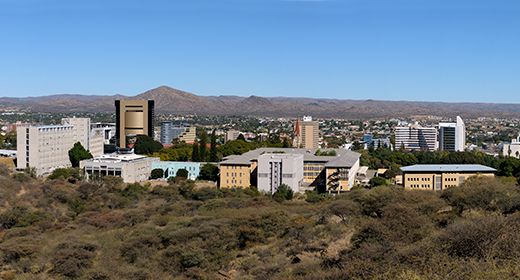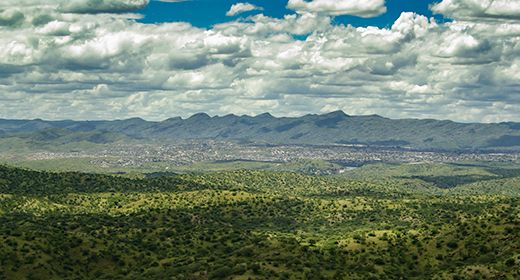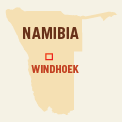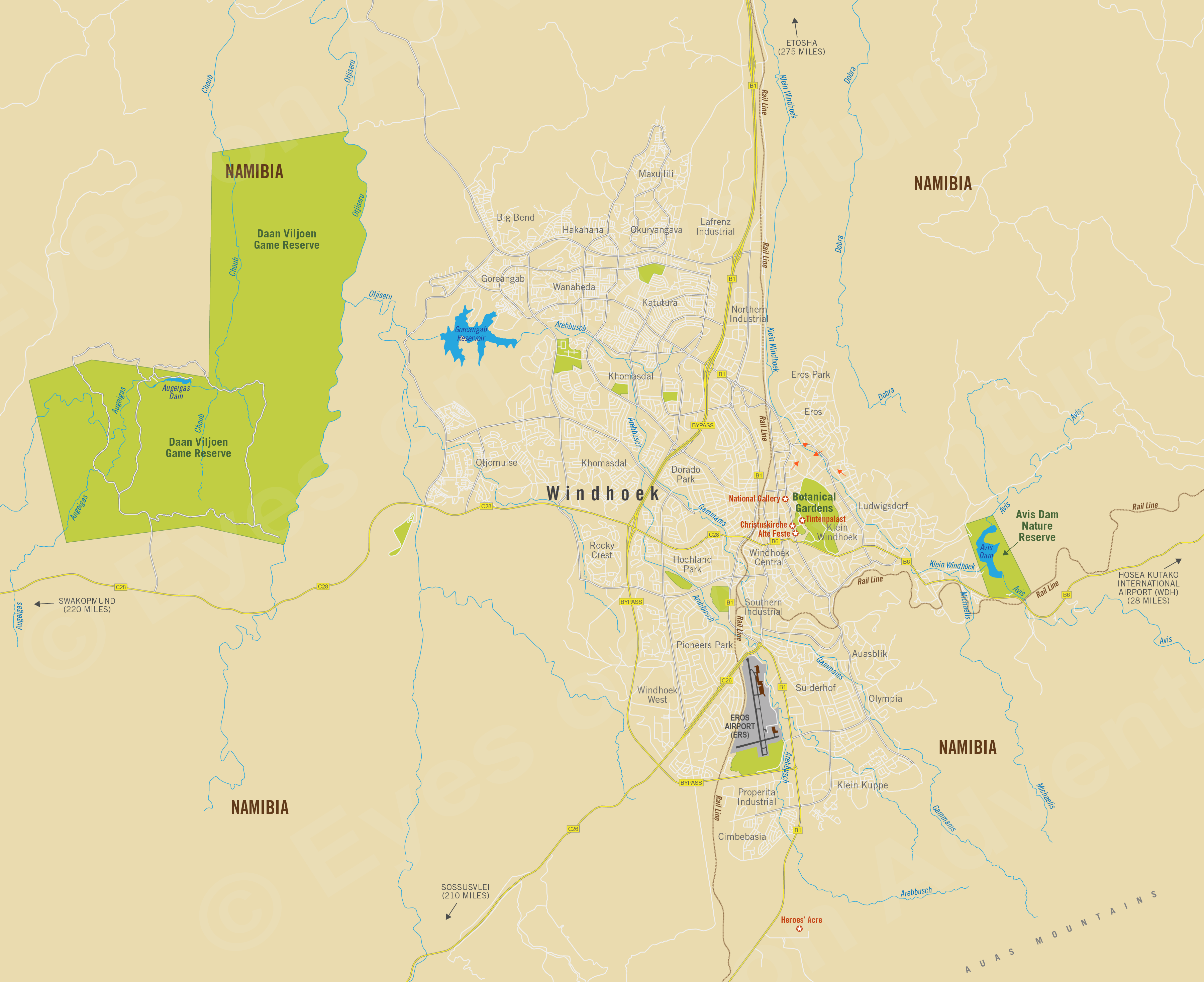Windhoek
Region Links: Caprivi / Zambezi, Damaraland & Waterberg, Etosha, Namib Desert & Sossusvlei, Skeleton Coast, Kaokoland & Kunene, Swakopmund, Windhoek
Highlights
- Namibia's capital city is safe and offers a wide range of accommodation
- Most tours in Namibia start and end in Windhoek and require overnights
- Explore the city for historic architecture, museums, art galleries, and craft markets
- Go hiking in the game-rich Daan Viljoen Game Reserve located closeby
EOA Recommends: Galton House, Hotel Heinitzburg, Olive Exclusive Boutique Hotel, Olive Grove Guest House
Windhoek is Namibia's capital and its largest city. Located in the geographic center of the country on the Khomas Highland Plateau, almost all visits to the country begin here.
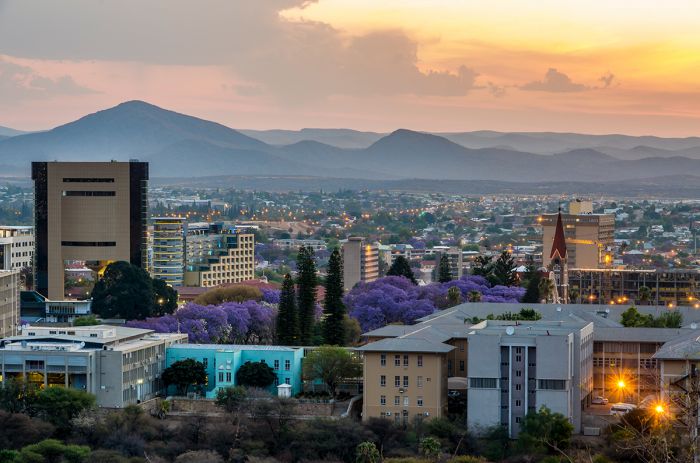
Sunset over Windhoek with jacaranda trees in full flower
Windhoek is not a city with many attractions, but is certainly worth a day or two to discover its charming mix of European and African cultures. Things to see and do include visits to open-air markets, museums, the National Gallery, shopping, and brewery tours.
The city is rather young and small for a capital, dating back to the 1890s and with a modest population of around 330 000. Founded by German settlers, the downtown area retains some interesting old architecture. The official language is English, but German is widely spoken here and in many of the country's farming areas.
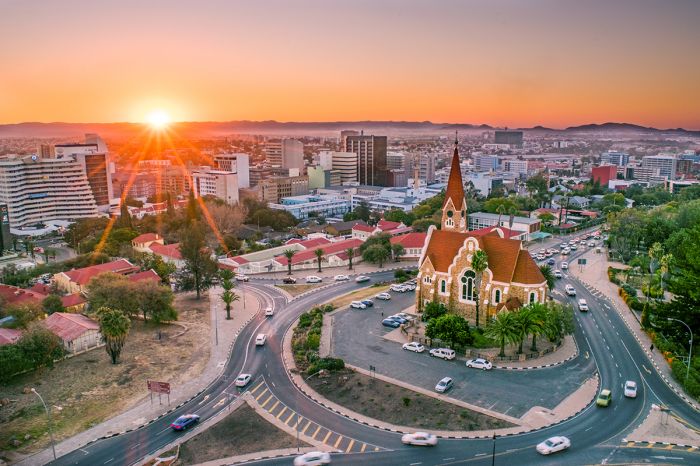
View over Windhoek's city centre with the historic Christ Church
The friendly and relaxed city center area can be explored easily on foot and is considered very safe. Here there are numerous good hotels, guest houses, restaurants and shops.
If you have an extra day, the Daan Viljoen Game Reserve is a short drive from town and offers diverse wildlife and excellent hiking trails (there are no lions, elephants or buffalo).
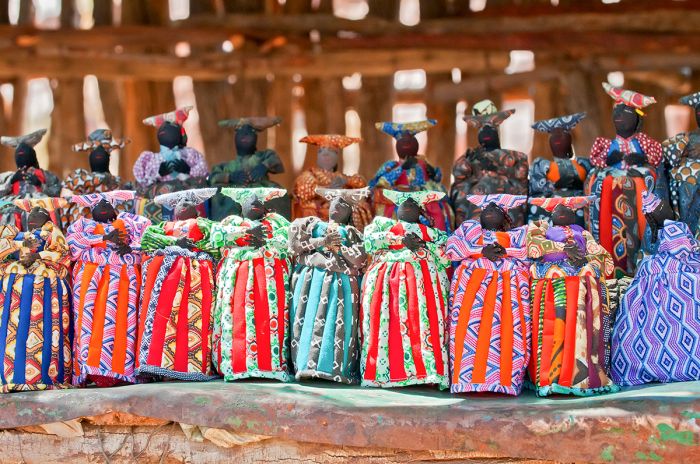
Herero dolls for sale at a market in Windhoek
The international airport is located 28 miles east of the city and driving or flying tours throughout the country almost always begin and end in Windhoek.
Read More...
Attractions, Daan Viljoen Game Reserve, History, Katutura, Trains
History
In 1840, the first settlement at Windhoek was established by the Orlam people, who were led by a man named Jonker Afrikaner. The Orlam were a mixed-race clan of people living in South Africa's Western Cape, who were descendants of indigenous Khoikhoi, Europeans, and slaves from India, Mozambique and Madagascar. Jonker led his people from their homes on the outskirts of the Cape Colony to escape servitude to the Dutch Boers, who were themselves migrating away from British rule in the Cape and thus taking over lands inhabited by the Orlam.
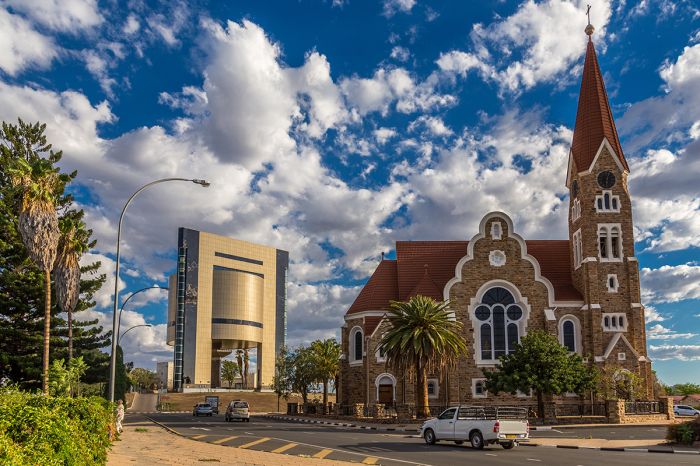
Christ church and the Independence Memorial Museum in Windhoek
The site was chosen for its natural springs, which provided water for cultivation. Jonker and his followers built a church for a congregation of between 500 and 600 in what is today Klein Windhoek and for a while the town prospered with a population of roughly 1 500 ethnic Orlam people.
The settlement grew around trading with the coast and cattle-raiding excursions carried out against the Herero groups to the north. These cattle raids eventually resulted in Jonker's death, after which his followers dispersed and by the early 1870s, the settlement was abandoned.
The first recorded use of the name 'Windhoek' was used in a letter written by Jonker in 1844, but the reason for the name he chose is unclear. Some believe it was a reference to the area's similarity to Winterhoek, his birthplace in the Cape while others think it may be a literal translation from Afrikaans ("windy corner").
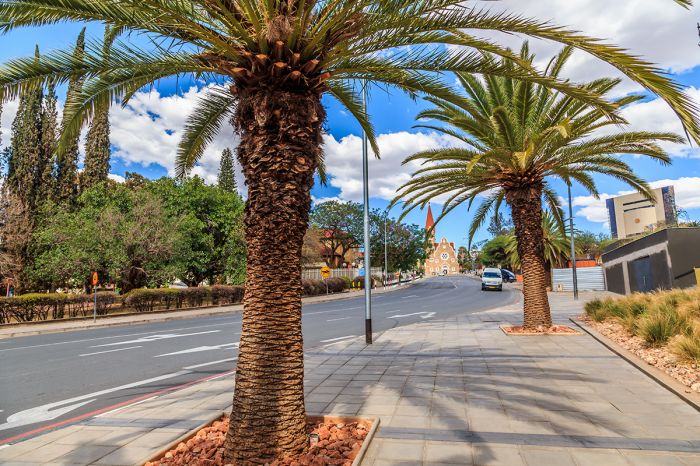
Palm-lined street in Windhoek's City Center
In 1884, Germany declared the entirety of what is today Namibia, with the exception of Walvis Bay, which was under British control, as a German Protectorate. By 1890, the borders of German South West Africa were established and a military unit, the Shutztruppe, under the command of Curt von François, was sent to maintain order. Von François chose Windhoek as the site for his garrison, which was strategically located between the tribal lands of the Nama (to the south) and Herero (to the north). In 1890, Von François designed and constructed the Alte Feste (Old Fortress), which served as the headquarters for the Stutztruppe.
In 1902, a railway was opened, connecting Windhoek to Swakopmund on the Atlantic coast and this led to sudden growth in the city's population. Mores settlers arrived from South Africa and Germany and indigenous people migrated from the outlying lands to seek work.
Windhoek was declared an official municipality in 1909, and during this time, many of its landmark buildings were built. The Christuskirche (Christ Church) was constructed between 1907 and 1910 and Windhoek's three castles, Schwerinsburg, Heinitsburg, and Sanderburg, were constructed between 1913 and 1919.
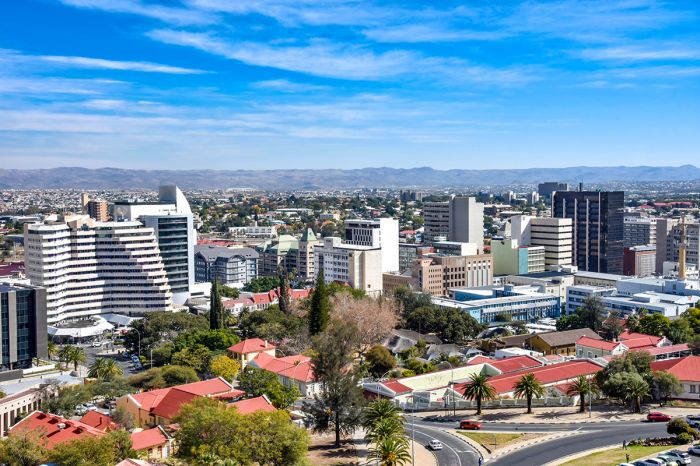
View over Windhoek, Namibia
In 1915, with the end of World War I, a League of Nations mandate granted administration of South West Africa to the United Kingdom, with South Africa serving as acting administrator. During the following few decades, growth in the country essentially stopped.
After World War II, growth in Windhoek resumed until the late 1950s and early 1960s, when South Africa began implementing apartheid policies. In December 1959, protests over the apartheid policies turned violent and forceful resettlement followed. Most of Windhoek's black population were moved to areas north of the city centre, creating the townships.
Apartheid continued throughout the 1970s and 1980s with rigid enforcement of skin-color-based segregation policies. The privileged whites lived in the lush neighborhoods around the city centre, while blacks lived mostly in Katutura and those designated as 'coloureds' (mixed race) in Khomasdal.
Namibia gained independence as a country in 1990 and Windhoek has experienced modernization, development and growth ever since.
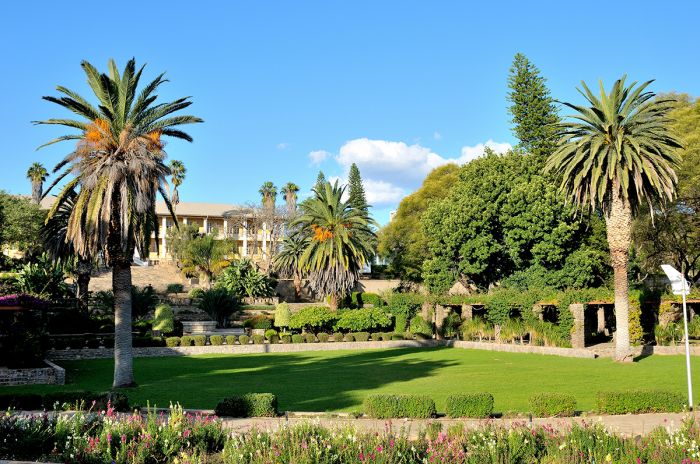
Tinten Palast (Ink Palace), the Parliament building in Windhoek
Attractions
While Windhoek should not really be considered a destination itself, it does have things to see and do if you have more than just a quick overnight, including some lovely old architecture, craft markets, museums, galleries, and more.
The city centre (Windhoek Central) and the neighborhoods of Eros, Klein Windhoek, and Ludwigsdorf are close to one another and offer the most to see and do.
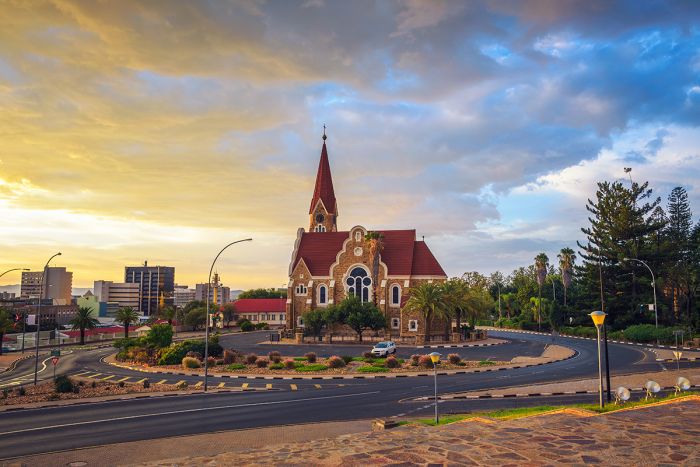
Christuskirche ("Christ Church") in Windhoek, Namibia
Christuskirche ("Christ Church") is perhaps the most recognized building in Windhoek. Designed by Gottlieb Redecker and built from sandstone between 1907 and 1910, this German Lutheran church is considered part art nouveau and part Neo-Gothic in style.
Tintenpalast ("Ink Palace") is the former administrative headquarters of German South West Africa and today serves as the country's parliamentary building. The surrounding gardens are lovely and the views of the city are superb. Tours are offered several times per day on weekdays.
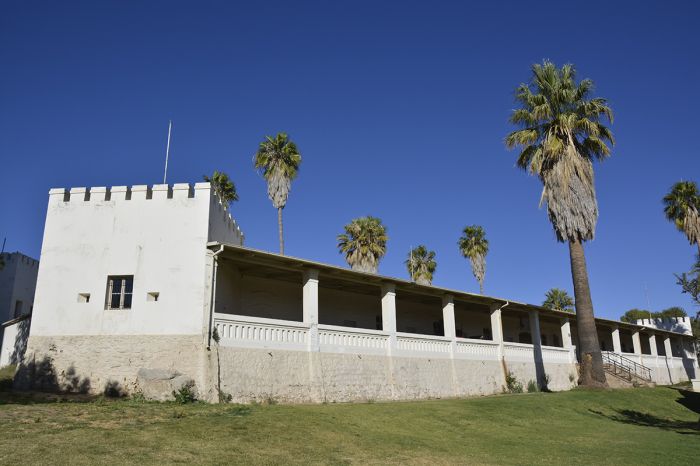
Alte Feste, the original fortress for the Schutstruppe in Windhoek
Alte Feste is the original fort built in 1890 to house the Shutztruppe, the first German army garrison stationed in German South West Africa. The fort is now part of a museum complex that includes the Independence Memorial Museum and the National Museum of Namibia, both situated next door.
The National Gallery of Art houses a permanent collection of Namibian art, reflecting the history and culture of the country. Various visiting exhibitions are also hosted here.
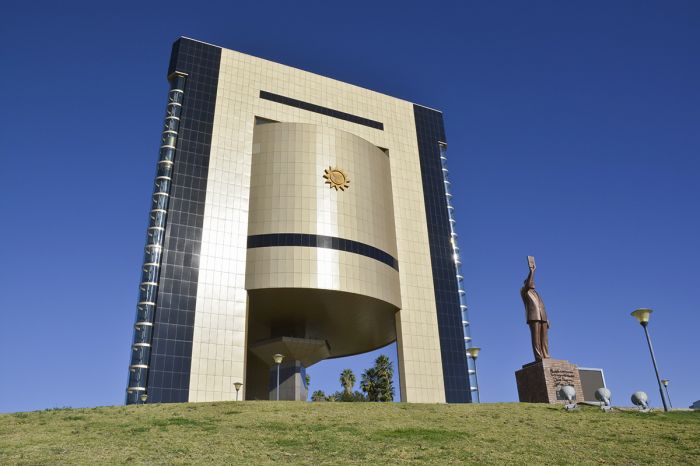
The Independence Memorial Museum in downtown Windhoek
Just south of the city along the B1 road is Heroes' Acre, a monument commemorating the Namibian struggle for independence. Completed in 2002, the memorial includes a 25-foot tall wall panel, various statues, a 500-seat pavilion, and a restaurant.
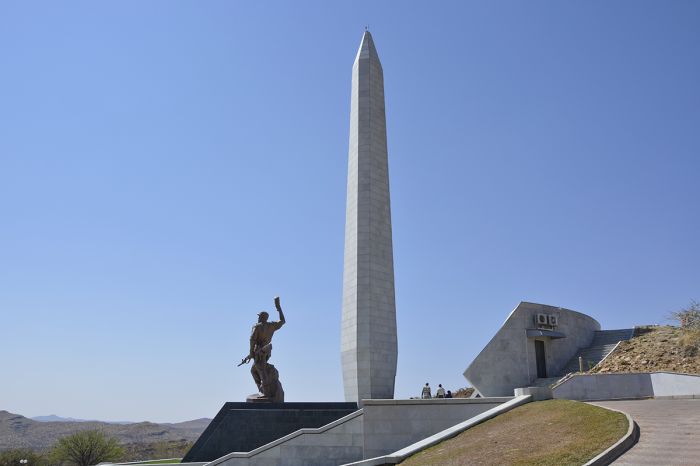
Heroes' Acre, just south of Windhoek
Katutura
In the late 1950s, the South African government, which had administrative control over South West Africa, began implementing racial separation polices in Windhoek. Protests and boycotts in 1959 led to unrest and violence, after which the government forcibly resettled Windhoek's non-white residents from their homes in Klein Windhoek and other areas near the city center, to areas north of the city.
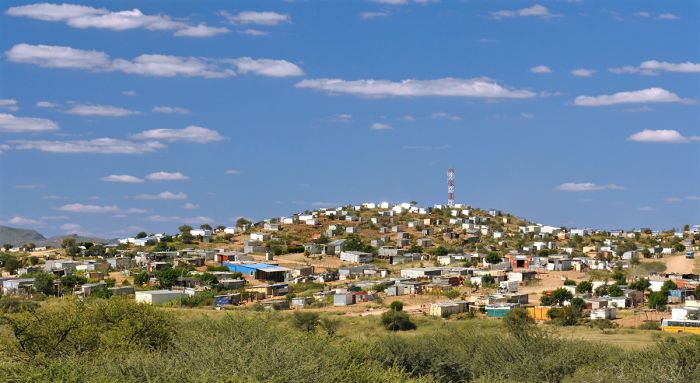
Shanty dwellings in the Katutura township in Windhoek
The first such settlement was Katutura, which in the Herero language means 'we have no permanent place'. It is in many ways, similar to the township of Soweto in Johannesburg. Tours of Katutura are a popular activity and many of the Windhoek city tours include a stop at this township.
Daan Viljoen Game Reserve
Located about 11 miles (18 kms) west of Windhoek is the wildlife-rich Daan Viljoen Game Reserve. Officially proclaimed in 1962, the reserve is characterized by desert hills and scrub vegetation typical of Namibia's central highland region.
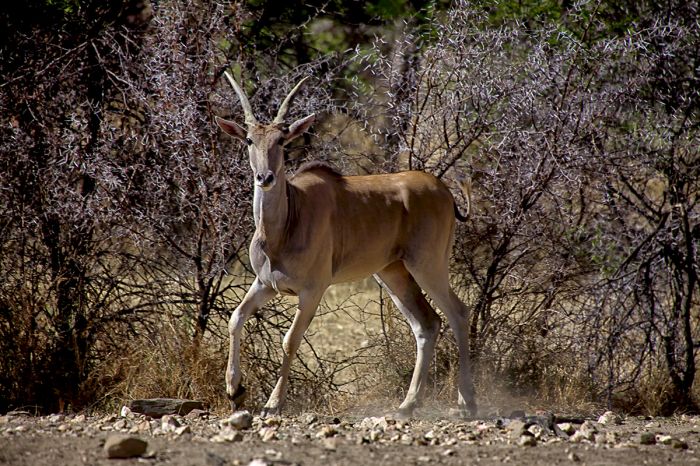
An eland in the Daan Viljoen Game Reserve near Windhoek, Namibia
Hiking is a speciality in the reserve and there are several well-marked trails, one of which takes 2 days, but most are much shorter. There are no lions, elephants, or buffalo here, so walking is perfectly safe. You will see wildlife though, as there are healthy populations of Hartmann's mountain zebra, greater kudu, oryx, and impala. Other species here include giraffe, red hartebeest, blue wildebeest, and eland.
Birding in the reserve is good, especially for regional endemics such as Monteiro's hornbill, Rockrunner, white-tailed shrike, Rüppell's parrot, and rosy-faced lovebird.
Trains
TransNamib is the state-owned rail service operator in Namibia. The first rail lines were laid in 1895 to connect Windhoek to Swakopmund and the route was opened for operation in 1902. The German Colonial railway was linked to South Africa's rail network after World War I.
Today, passenger rail service is offered between Windhoek, Swakopmund, Otjiwarongo, and Tsumeb (near Etosha). The StarLine service offers affordable, daily service to all major towns on these routes. The Desert Express is a luxury experience offering onboard accommodation and dining. Tour options include overnight weekend trips between Windhoek and Swalopmund, as well as 7- to 10-day excursions to the south or to Etosha.
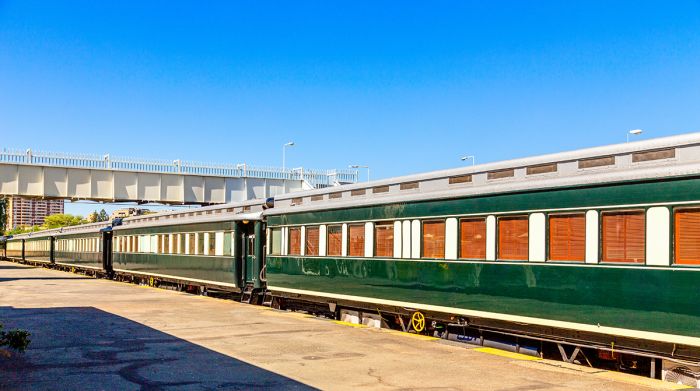
Passenger train in Windhoek, Namibia
Read More...
Attractions, Daan Viljoen Game Reserve, History, Katutura, Trains
Great Good Fair Poor
- Jan
- Feb
- Mar
- Apr
- May
- Jun
- Jul
- Aug
- Sep
- Oct
- Nov
- Dec
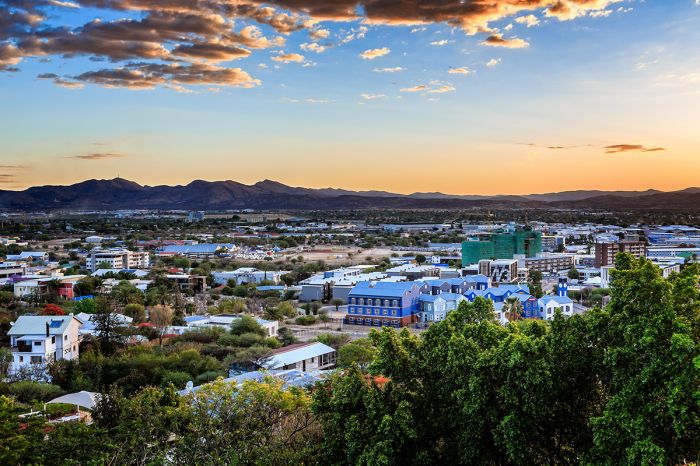
Sunset over a Windhoek neighborhood
Year-Round Destination
Windhoek is located on Namibia's Central Plateau, which has an elevation of around 5 600 feet (1 700 meters) and experiences a semi-arid climate. Windhoek's elevation gives it a somewhat cooler climate than much of the country, but overall, it experiences dry weather for most of the year, with warm to hot days and cool nights. Windhoek and the entire country are year-round destinations.
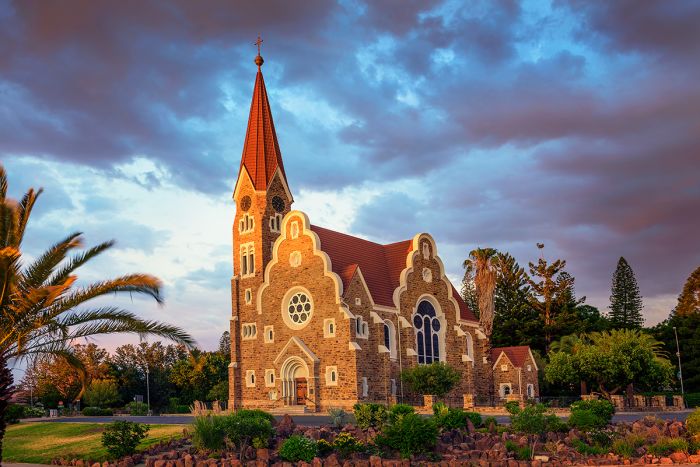
Christuskirche (Christ church) in Windhoek
Winter
The winter months are May thru October, with little to no rain, comfortably warm days, and chilly nights. Daytime temps average between 68-75°F (20-24°C), while nighttime temps average 40-45°F (4-7°C), but can drop below freezing on occasion. Rain is extremely rare during the winter.
Summer
The summer months are November thru April, with warm to hot days and a chance of afternoon rain showers. Daytime temps average 80-88°F (27-31°C), but can reach 95-100°F (35-38°C). Nights are cool and comfortable, averaging 55-60°F (13-16°C). The first rains arrive in late November or early December. Rain usually occurs as heavy afternoon showers, but not every day. January and February are the hottest months and receive the most rain.
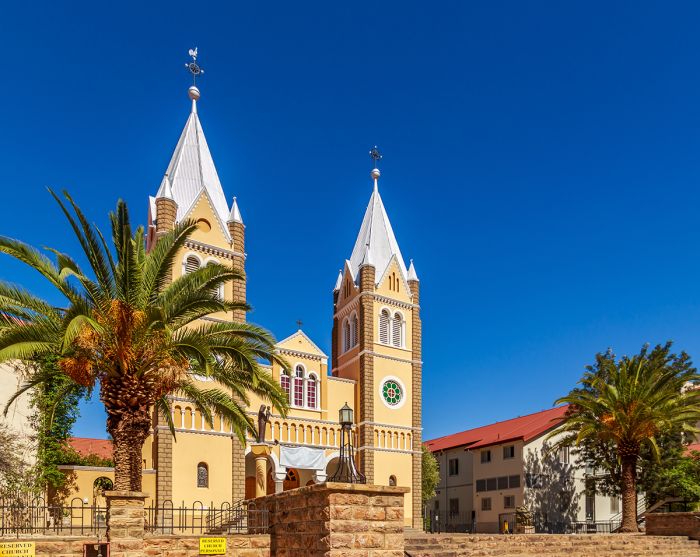
St Mary's Catholic Cathedral Church in Windhoek




